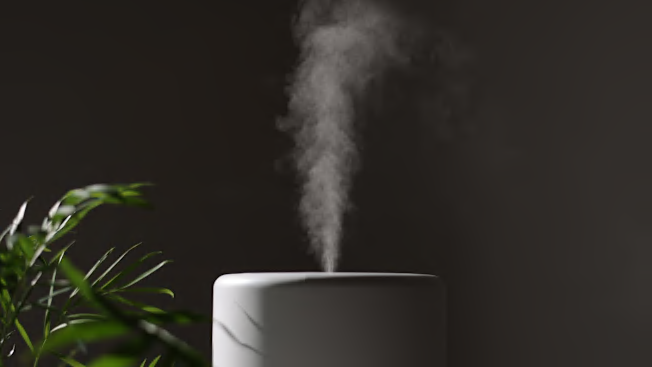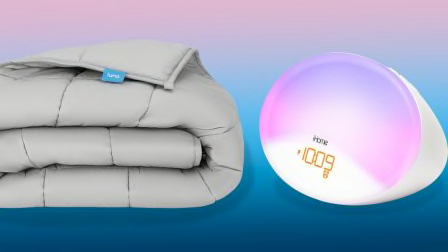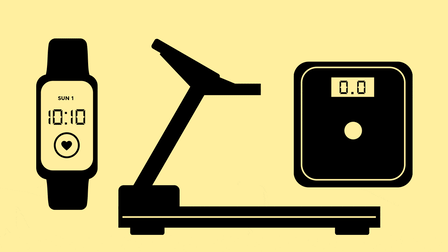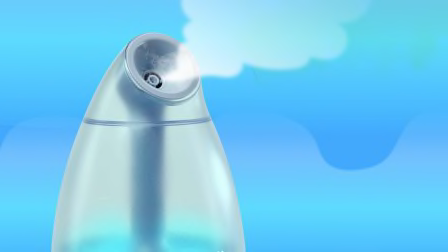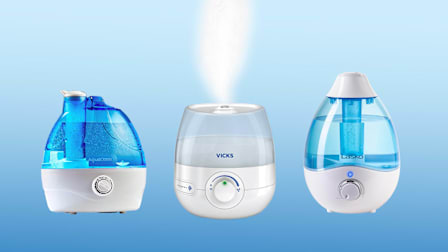Top Reasons to Buy a Cool-Mist Humidifier
A cool-mist humidifier can help maintain skin moisture and prevent dryness — plus, the top-rated models from our tests are especially quiet and efficient
When you shop through retailer links on our site, we may earn affiliate commissions. 100% of the fees we collect are used to support our nonprofit mission. Learn more.
Cool-mist humidifiers are the choice of most Americans seeking to alleviate dryness in their homes. These machines dominate the market because they pose fewer safety risks than warm-mist humidifiers, also known as vaporizers.
Unlike warm-mist humidifiers, cool-mist versions add moisture to indoor air without boiling water and producing steam. With no potential to burn or scald, cool-mist humidifiers are the only humidifier type that pediatricians recommend for households with babies and young children.
“They’re also the best choice for homes with pets prone to investigating mysterious appliances,” says Misha Kollontai, who leads humidifier testing at Consumer Reports.
Read below for more on the advantages of cool-mist humidifiers, and see the best cool-mist models in each of the humidifier sizes Consumer Reports tests. For test results and more options, CR members can check our complete humidifier ratings, which include units that range from personal size all the way up to consoles that can humidify 1,000 square feet or more.
- Benefits of a Cool-Mist Humidifier
- Best Cool-Mist Humidifiers: Travel/personal-sized Small Room Medium Room Large Room
- How CR Tests Humidifiers
Benefits of a Cool-Mist Humidifier
Even in homes without curious critters or toddling tots, cool-mist humidifiers have benefits. Here’s how they excel over other types.
Energy efficiency: Cool-mist models use significantly less energy than warm-mist models. The reason is that they work without boiling water, which requires a fair amount of electricity, Kollontai says. Depending on the unit’s style, a cool-mist humidifier uses one of two mechanisms to add moisture to the air.
Where a Cool-Mist Model Has No Advantage
One area where cool-mist humidifiers have no edge is in how well they do their basic job: adding moisture to the air. “Cool- and warm-mist units are equally effective at humidifying,” Kollontai says.
There’s also no way to generalize about which type is easier to clean. “It depends largely on the design,” Kollontai says. With either type, though, it’s crucial to clean the components regularly to prevent the growth of mold spores and other nasties that can lead to illness. Check the manufacturer’s directions for cleaning, as well as Consumer Reports’ advice on this key task.
When to Opt for a Warm-Mist or Dual-Mist Humidifier
The main reason for using a warm-mist humidifier is noise. Warm-mist models tend to be quieter because they don’t need a fan, nebulizer, or vibrating diaphragm to move moisture into the air. “The steam naturally escapes the tank,” Kollontai says.
For the best of both worlds, consider buying a dual-mist version, which lets you choose between cool and warm mist. There are 12 dual-mist units in CR’s ratings; two of these, sized for rooms between 300 and 499 square feet, have excellent Overall Scores. Six others, sized for larger rooms, have very good Overall Scores. “A dual-mist model allows you to take advantage of the soothing warm mist only when you truly think you need it, and to take advantage of the energy savings of cool otherwise,” Kollontai says.
Just steer clear of dual-mist units if you have kids or pets, because an inadvertent turn of the dial or press of a button can activate potentially scalding steam.
Best Cool-Mist Humidifiers From CR's Tests
Choose the size that’s closest to the square footage of the space you want to humidify. These top-rated models earn solid scores for convenience, noise, and efficiency.
Travel/Personal (up to 25 sq. ft.)
Small Room (26 to 299 sq. ft.)
Medium Room (300 to 499 sq. ft.)
Large Room (500 to 999 sq. ft.)
How CR Tests Humidifiers
In Consumer Reports’ humidifier lab, we evaluate models on six criteria: moisture output, convenience, noise, energy efficiency, humidistat accuracy, and output using hard water.
Our moisture output tests are conducted in a chamber set to 70° F and 30 percent relative humidity, an industry standard for testing humidifiers. Manufacturers typically claim that their humidifiers are intended for a specific room size or area, so we measure a humidifier’s moisture output and calculate how well it does in the specified area.
We also gauge how convenient a humidifier is to use. Our testers assess how easy it is to set up and operate, as well as how easy it is to clean, which is important because you may need to empty the tank daily and clean the humidifier regularly to prevent bacteria from developing. We measure the sound (in decibels) that a humidifier generates when it’s running at its highest speed. Some are louder than others, and if you use a humidifier in your bedroom, you’ll want to steer clear of noisy models that could disturb your sleep.
Testers calculate the amount of energy each model uses to emit a gallon of water into the air. Our humidistat accuracy test measures how well each humidifier reaches and maintains a set humidity level.
Finally, we test a humidifier’s moisture output when hard water is used. We conduct this test because the dissolved minerals in hard water can clog a humidifier, which decreases its moisture output.

















